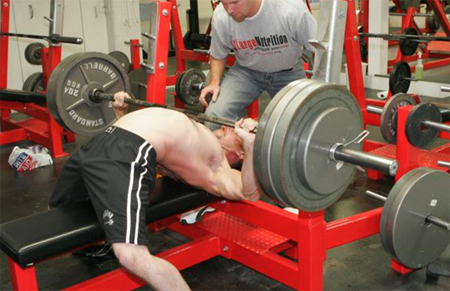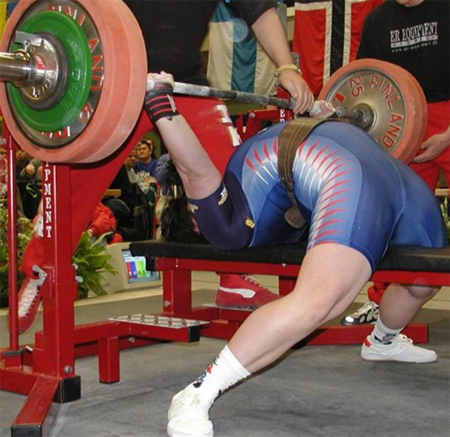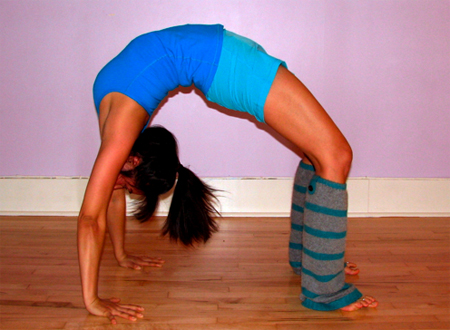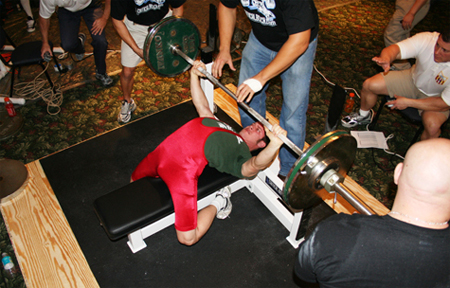mugzy
TID Board Of Directors
- Aug 11, 2010
- 4,876
- 1,800
Later in the article, I will get into the different types of stretches and training to do for arching but I want to begin by describing the shape and setup of the arch and how it provides both an incredible base and leverage for power. Just like the arch in a bridge supporting tons of pounds, the arch in the bench press is an excellent distributor of the load on ones body. In the typical "flat backed" bencher, nearly all the weight is positioned on the upper back. When using an arch, most of the weight is placed on the traps and a significant portion of this weight is also supported by the legs because of how they are positioned. When setting up for this type of arch, position yourself by getting under the bar and place your upper traps on the bench. Retract your shoulder blades together tight. Pull your legs/feet back as far as you are able. At this point you will be on your toes only. By pulling or tucking your legs back, your feet will be positioned directly under the load. Note the picture below for an example. In the picture, the bencher (Joe Luther, 165) has 3 points of contact, his shoulders, butt and feet. Notice that he is on his upper traps and his feet are pulled all the way back. The trick here is that although he is making contact with his butt, he is putting virtually no load at that point, it is simply just touching. All the weight is going straight to his legs not his butt, providing significant support. When in full arch position, our chests are in alignment with the large lat muscles, thus providing an even plane for all muscles to work simultaneously together.

The next element and probably most important is the aspect of mechanical advantage or leverage. A simple illustration of this is a bicycle. In other words, it is easier for you to move a bike in 2nd gear than it is for you to move it in 1st. Therefore, the rider is actually using LESS power to move the bike faster. The same is true with the bench press. No, we don't as humans come equipped with "gears" but we do come equipped with a flexible body, where we can imitate the nature of this mechanical advantage. Let me build on this.
The most obvious factor in the arch is the distance of motion. Let me ask you a question. Is powerlifting a competition to see who is stronger or who can lift more weight? Obviously, the lifter who lifts the most wins. The key here is power production. Let's say I max bench 375 and a fellow competitor max benches 375 as well. The formula for power is (Force x Distance) / Time. The distance from the peak of my arch to lockout is roughly 7-8 inches. It would take me about 1 second to lift the weight. Using those numbers, my power output would be 247 units. Take a standard flat bencher benching the same weight. A standard arm length would be 22 in. and let's say it takes him 1.5 seconds to execute the lift. That would equal 458 units. It is obvious to see that because of my mechanical advantage, I am actually using less power to lift the same weight; just like shifting gears on a bike.
Check out the picture below of what I consider the best arch setup I have ever seen. Here, the bencher has only about 6 inches of work to do. Notice how the chest, triceps, lats and delts are in complete concert in a level plane. This small lifter is by no means lifting a small amount of weight but I guarantee that the power required to lift it is significantly less than what a flat bencher would require.

So now that we have this advantage how does one develop it? I will go thru some simple principles and exercises one can do to increase the arch. Make sure to follow the following guidelines or severe injury may occur. Stay in control of the stretches. Do not bounce at all! Do what you can do not what you can't. Work to get better and BREATHE, in through the nose and out through the mouth. This is not a race. If you feel any pain at all stop! (Not to confuse pain with discomfort) Now let's get to it.
Take your time. The important thing is that you are stretching and working with what you can do not what you can't.
The next back stretch is what is called the wheel (Pictured below). To execute this stretch, lay on your back with your knees bend up. Place your hands on the floor next to the sides of your head so your fingers are towards your shoulders. Push up your body both with your hands and legs and stretch upwards. Take it slow, not everyone may be able to fully perform this. Again, work with what you can do not what you can't. Perform this again, 4 sets of 20 seconds. Try moving around a bit when in this pose to loosen up some of the vertebrae.

The third movement is very familiar to most powerlifters and that is the use of a pipe or PVC under the small of our back. Although I no longer perform this exercise, I almost exclusively used it in the beginning when I first started working with my arch. I did a variation of this though. Instead of using a pipe I used a hex-shaped dumbbell. The reason for the hex is so the dumbbell would not roll around while lifting and it leaves a clear passage for your spine in the center so you are not smashing your spine against anything. It also is very stable if you put a small towel folded up over the top of the dumbbell it actually becomes very comfortable. What I did was actually bench using these hex dumbbells under my back. I started out with a 20lb. dumbbell. I placed the dumbbell on the bench in the spot I knew my arch was going to be then I got on the bench and positioned myself around the dummbell in arch form making sure my shoulders and butt were touching the bench. I performed every rep of every set using this technique. I gradually increased the size of the dumbbell with each workout as my back allowed. When I stopped doing this I was able to place a 70lb. dumbbell under my back with all points of contact achieved.
Take your time with these stretches and techniques. It will not bring you success over night but it will make a difference if practiced. If these come easy to you and you want some more challenging stretches, let me know and I will be glad to explain the stretches true contortionists use for back flexibility.
I will now go on to describe some actual lifting exercises I use while "arch training". If you wish to follow my workouts please visit bmfsports.com and go to the BMF forum where all the athlete logs are posted. Before I begin though, I want to make a couple quick points. I do not recommend training with an arch in every workout as it places a constant stress on your vertebrae that is not necessary. Also, by always training with an arch you will lose a lot of your lower end torque/power as well. So how do I train for an arch bench when I do not use an arch in workouts? The answer is that I simulate the arch through different lifts.

The first lift that I do for an arch bench is the rack lockout. What I do is set the rack pins at the level of my arch while keeping my back slightly arched. I then perform low volume sets with this setup.
The second lift I do is flat bench with Board work. What I do here is I perform a typical flat bench workout with NO arch. That's right; I keep my back relatively flat while retracting my shoulder blades. This is strictly for low end power and to ensure you have a strong base below the arch when it's used in competition. After the flat bench work I jump into board work. I use a medium arch here just so I can get the feel of being on my upper traps. I work with 1-4 boards. This also simulates the max arch and also overloads the lift just like in a regular workout.
The last core lift I do to simulate the arch is the decline press. This is probably the best imitator for obvious reasons. There are many more additional assistance lifts I perform but these are the core ones. A sample basic routine for me would be as follows:
by Neal Dreisig

The next element and probably most important is the aspect of mechanical advantage or leverage. A simple illustration of this is a bicycle. In other words, it is easier for you to move a bike in 2nd gear than it is for you to move it in 1st. Therefore, the rider is actually using LESS power to move the bike faster. The same is true with the bench press. No, we don't as humans come equipped with "gears" but we do come equipped with a flexible body, where we can imitate the nature of this mechanical advantage. Let me build on this.
The most obvious factor in the arch is the distance of motion. Let me ask you a question. Is powerlifting a competition to see who is stronger or who can lift more weight? Obviously, the lifter who lifts the most wins. The key here is power production. Let's say I max bench 375 and a fellow competitor max benches 375 as well. The formula for power is (Force x Distance) / Time. The distance from the peak of my arch to lockout is roughly 7-8 inches. It would take me about 1 second to lift the weight. Using those numbers, my power output would be 247 units. Take a standard flat bencher benching the same weight. A standard arm length would be 22 in. and let's say it takes him 1.5 seconds to execute the lift. That would equal 458 units. It is obvious to see that because of my mechanical advantage, I am actually using less power to lift the same weight; just like shifting gears on a bike.
Check out the picture below of what I consider the best arch setup I have ever seen. Here, the bencher has only about 6 inches of work to do. Notice how the chest, triceps, lats and delts are in complete concert in a level plane. This small lifter is by no means lifting a small amount of weight but I guarantee that the power required to lift it is significantly less than what a flat bencher would require.

So now that we have this advantage how does one develop it? I will go thru some simple principles and exercises one can do to increase the arch. Make sure to follow the following guidelines or severe injury may occur. Stay in control of the stretches. Do not bounce at all! Do what you can do not what you can't. Work to get better and BREATHE, in through the nose and out through the mouth. This is not a race. If you feel any pain at all stop! (Not to confuse pain with discomfort) Now let's get to it.
Take your time. The important thing is that you are stretching and working with what you can do not what you can't.
The next back stretch is what is called the wheel (Pictured below). To execute this stretch, lay on your back with your knees bend up. Place your hands on the floor next to the sides of your head so your fingers are towards your shoulders. Push up your body both with your hands and legs and stretch upwards. Take it slow, not everyone may be able to fully perform this. Again, work with what you can do not what you can't. Perform this again, 4 sets of 20 seconds. Try moving around a bit when in this pose to loosen up some of the vertebrae.

The third movement is very familiar to most powerlifters and that is the use of a pipe or PVC under the small of our back. Although I no longer perform this exercise, I almost exclusively used it in the beginning when I first started working with my arch. I did a variation of this though. Instead of using a pipe I used a hex-shaped dumbbell. The reason for the hex is so the dumbbell would not roll around while lifting and it leaves a clear passage for your spine in the center so you are not smashing your spine against anything. It also is very stable if you put a small towel folded up over the top of the dumbbell it actually becomes very comfortable. What I did was actually bench using these hex dumbbells under my back. I started out with a 20lb. dumbbell. I placed the dumbbell on the bench in the spot I knew my arch was going to be then I got on the bench and positioned myself around the dummbell in arch form making sure my shoulders and butt were touching the bench. I performed every rep of every set using this technique. I gradually increased the size of the dumbbell with each workout as my back allowed. When I stopped doing this I was able to place a 70lb. dumbbell under my back with all points of contact achieved.
Take your time with these stretches and techniques. It will not bring you success over night but it will make a difference if practiced. If these come easy to you and you want some more challenging stretches, let me know and I will be glad to explain the stretches true contortionists use for back flexibility.
I will now go on to describe some actual lifting exercises I use while "arch training". If you wish to follow my workouts please visit bmfsports.com and go to the BMF forum where all the athlete logs are posted. Before I begin though, I want to make a couple quick points. I do not recommend training with an arch in every workout as it places a constant stress on your vertebrae that is not necessary. Also, by always training with an arch you will lose a lot of your lower end torque/power as well. So how do I train for an arch bench when I do not use an arch in workouts? The answer is that I simulate the arch through different lifts.

The first lift that I do for an arch bench is the rack lockout. What I do is set the rack pins at the level of my arch while keeping my back slightly arched. I then perform low volume sets with this setup.
The second lift I do is flat bench with Board work. What I do here is I perform a typical flat bench workout with NO arch. That's right; I keep my back relatively flat while retracting my shoulder blades. This is strictly for low end power and to ensure you have a strong base below the arch when it's used in competition. After the flat bench work I jump into board work. I use a medium arch here just so I can get the feel of being on my upper traps. I work with 1-4 boards. This also simulates the max arch and also overloads the lift just like in a regular workout.
The last core lift I do to simulate the arch is the decline press. This is probably the best imitator for obvious reasons. There are many more additional assistance lifts I perform but these are the core ones. A sample basic routine for me would be as follows:
- Monday - Rack lockouts, 5x5
- Thursday - Flat bench, 5x5; 4 board, 3x2
- Monday - Rack lockouts, 3x8
- Thursday - Decline, 8x3
by Neal Dreisig
